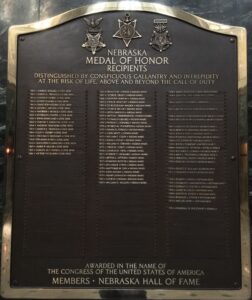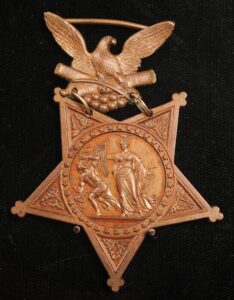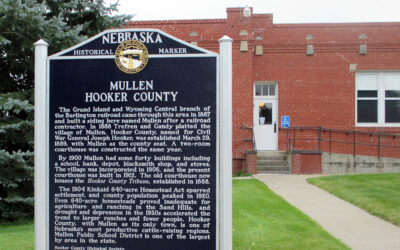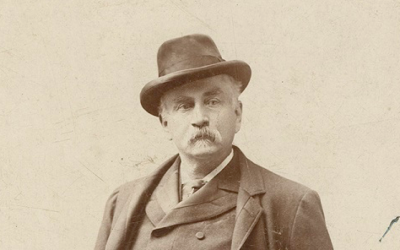
Nebraska Medal of Honor Plaque, Nebraska State Capitol, Memorial Chamber, Capitolist CC BY-SA 4.0
The Congressional Medal of Honor is the highest military decoration that is awarded to American armed service members who distinguish themselves with certain acts of valor.
Several members of the armed forces from Nebraska have been awarded this honor. In total there are twenty Medals of Honor accredited to the state of Nebraska, which means the state in which the service member was recruited from. Another eight Medal of Honor recipients were born in Nebraska. A further forty-eight service members awarded the Medal of Honor also have a connection to Nebraska, whether they briefly lived in the state, later settled here, or are buried in the state. A plaque in the state capitol building honors these service members; it is located in the Memorial Chamber on the fourteenth floor.
Below is a list of these Nebraskans and their service. Due to the length of some of these records only a brief summary of their actions will be placed in this article. If you would like to learn more about these service members please go to the Congressional Medal of Honor Society’s website to look up service members and their citations.
Medals of Honor Accredited to Nebraska
Civil War

Victor Vifquain’s Medal of Honor.
- Victor Vifquain for “Capture of flag” at Fort Blakely, Alabama. The Nebraska State Historical Society is the repository for Victor Vifquain’s Medal of Honor.
Indian Campaigns
- William Frederick Cody, better known as Buffalo Bill of the Wild West Show, was cited for “gallantry in action” at the Loupe Fork of the Platte River.
- Co-Rux-Te-Chod-Ish (Mad Bear) for “running out in pursuit of a dismounted Indian; was shot down and badly wounded by a bullet from his own command” near the Republican River, Kansas.
- John A Kirkwood for “bravely endeavoring to dislodge some Sioux Indians secreted in a ravine” at Slim Buttes, Dakota Territory.
- Francis W. Lohnes for “gallantry in defending government property against Indians” at Gilmans Ranch, Nebraska.
Spanish-American War
- George Francis Berg for “gallantly assisting in the rescue of the wounded while under heavy fire” at El Caney, Cuba.
- John Walter Ehle for “assisting in hauling the fires in the hot atmosphere which necessitate the play of water into the fireroom from a hose” off Cavite, Manila Bay.
Philippines (1911)
- Jacob Volz for “responding to calls for help from the advance scouting party instantly and blazing his rifle into the outlaws, destroying several of the Moros and assisting in routing the remainder” near the village of Mundang, Basilan Island.
World War I
- Ora Graves for “”extraordinary heroism when a 3-inch saluting charge exploded, causing the death of C.T. Lyles, seaman. Graves was blown to the deck, but recovered and discovered the burning deck. He put out the burning waste while the casemate was filled with clouds of smoke, knowing that there was more powder there that might explode” at sea aboard the USS Pittsburgh.
World War II
- Harold William “Indian Joe” Bauer for “participating in two air battles outnumbering our force more than two to one, boldly engaged the enemy, and destroyed one Japanese bomber in the engagement of 28 September, and shot down four enemy fighter planes in flames on 3 October, leaving a fifth smoking badly. After successfully leading an over-water ferry flight of more than 600 miles on 16 October, Lt. Col. Bauer sighted a squadron of enemy planes attacking the U.S.S. McFarland. He engaged the entire squadron and, although alone and his fuel supply nearly exhausted, fought his plane so brilliantly that four of the Japanese planes were destroyed before he was forced down by lack of fuel” at Guadalcanal, Solomon Islands.
- Robert D Booker for “conspicuous gallantry and intrepidity at the risk of life above and beyond the call of duty. While engaged in action against the enemy, carried a light machine gun and a box of ammunition over 200 yards of open ground. Although he was being targeted by multiple enemies, upon reaching his object he immediately commenced firing. After being wounded once he successfully silenced one enemy machine gun and then was mortally wounded. With his remaining strength he encouraged his squad and directed their fire” near Fondouk, Tunisia.
- Dale Merlin Hansen for “unhesitatingly taking the initiative during a critical stage of the action and, armed with a rocket launcher, crawled to an exposed position where he attacked and destroyed a strategically located hostile pillbox. With his weapon destroyed by enemy fire, he continued his one man assault with his rifle. He attacked a Japanese position killing several when his rifle jammed; he climbed back for cover, but promptly returned with a new weapon and grenades. With these he destroyed a strong mortar position and annihilated more of the enemy” at Okinawa Shima, Ryukyu Islands.
- John Joseph Parle for “valor and courage as officer-in-charge of small boats in the USS LST 37. During the amphibious assault on Sicily. Realizing the detonation of explosives would prematurely disclose to the enemy the assault. Ens. Parle risked his life to extinguish a smoke pot accidentally ignited on a boat with explosives. After failing to first put it out he seized it with both hands and threw it into the ocean. Ens. Parle died a week later from smoke and fumes inhaled” at Sicily.
Korean War
- Edward Gomez for “boldly advancing with his squad in support of a group of riflemen assaulting a series of strongly fortified positions on Hill 749. Pfc. Gomez consistently exposed himself to the withering barrage to keep his machine gun supplied during the drive forward to the objective. As his squad deployed to meet an imminent counterattack, he voluntarily moved down an abandoned trench to search for a new location for the gun and, when a hostile grenade landed between himself and his weapon, he grasped the grenade and determining to save his comrades, dove into a ditch with the grenade and absorbed the impact with his body” at Hill 479, Korea.
- Ernest Richard Kouma. “M/Sgt. Kouma, a tank commander in Company A, distinguished himself by conspicuous gallantry and intrepidity at the risk of his life above and beyond the call of duty in action against the enemy. His unit was engaged in supporting infantry elements on the Naktong River front. During the fighting some units took heavy casualties and M/Sgt. Kouma was given the command to cover their withdrawal, against great odds he held his ground for over nine hours. After rejoining his company, despite his injuries, he attempted to resupply his tank and return to action. While being evacuated for medical treatment, he again asked to rejoin the fight” vicinity of Agok, Korea.
Vietnam War
- James Williams Fous for “action during a reconnaissance-in-force mission when his unit formed its perimeter defense for the night. Pfc. Fous detected three Viet Cong coming toward him, after alerting others directed their fire at the enemy. One enemy escaped, and threw a grenade at Pfc. Fous’ position. Without hesitation Pfc. Fous hurled himself upon the grenade, absorbing the blast with his body and saving lives of the other men in the area” in Kien Hoa Province, Republic of Vietnam.
- Charles Chris Hagemeister for “conspicuous gallantry and intrepidity in action while conducting combat operations when his platoon came under heavy attack. Sp5c. Hagemeister raced through the deadly fire to provide medical aid. He continued to brave withering fire and crawled forward to give lifesaving care. During the engagement to protect his fellow soldiers , Sp5c. Hagemeister seized a rifle and killed an enemy sniper. Unable to move the wounded he sought help from a nearby platoon, which aided in his move to evacuate the wounded, he then successfully repeated this action on the other flank while still drawing enemy fire” in the Binh Dinh Province, Republic of Vietnam.
- Miguel Keith for “risking his life above the call of duty while serving as a machine gunner with Combined Action Platoon 1-3-2. During the early morning L/Cpl. Keith was seriously wounded by enemy fire. Despite his wounds, he ran across the fire-swept terrain to check vital defensive positions and then delivered a hail of deadly machine gun fire. He repelled multiple attackers from his position and suffered further wounds from a grenade. He again charged another large group of enemy soldiers, killing four and dispersing the rest. During this effort he was mortally wounded, but his actions helped his platoon in routing a numerically superior force” in the Quang Ngai Province, Republic of Vietnam.
- Joseph Robert Kerrey for “actions while leading his SEAL team on a mission to capture important members of the enemy’s area political cadre. He and his team scaled a 350-foot sheer cliff to place themselves above the enemy. Splitting his team, Kerrey led his men downwards to the enemy’s camp. As they neared the bottom they came under enemy fire. During the action Lt. Kerrey was greatly injured by a grenade going off at his feet. Although suffering great pain he displayed great courage and state of mind by directing his element’s fire, and radioing the second element’s fire support which greatly disrupted the Viet Cong. He directed his men till he was evacuated by helicopter, despite being in a near unconscious state. The enemy captured provided vital intelligence that aided in the allied effort” near Nha Trang Bay, Republic of Vietnam.
Peace Time Awards
- Otto Diller Schmidt for “extraordinary heroism displayed on the USS Bennington at the time of the explosion of a boiler of that vessel at San Diego, Cal., 21 July, 1905.”
Medals of Honor Awarded to People Born in Nebraska
Spanish American War
- James Meredith for “action aboard the USS Marblehead during the operation of cutting the cable leading from Cienfuegos, Cuba. Facing the heavy fire of the enemy, Meredith displayed extraordinary bravery and coolness” in Cienfuegos, Cuba.
World War I
- Nelson Miles Holderman for “commanding a company of a battalion which was cut off and surrounded by the enemy. He was wounded on 4, 5, and 7 October, but through the entire period continued personally to lead and encourage the officers and men under his command. On October 6, he rushed through enemy machine-gun and shell fire and carried two wounded men to a place of safety” Northeast of Binarville, in the Argonne Forest, France.
World War II
- Floyd K Lindstrom for “action on 11 November, 1943 while his platoon was supporting a rifle company attacking a hill, when the enemy counterattacked, forcing the riflemen and half the machine gun platoon to retire to a defensive position. Pfc. Lindstrom, realizing his section was alone and outnumbered, directed the few remaining men into position and opened fire with his single gun. When he was unable to take out an enemy position, he moved under heavy fire to a new more effective position. He dashed out of this position several times to take out other enemy positions and to capture enemy weapons and ammunition to use against them. His spectacular performance broke the enemy’s counterattack” near Mignano, Italy.
- Richard Eller Cowan for “his actions during an attack by hostile infantry and tanks, where he maintained his position so the rest of the forces could set up a new line along a firebreak. Then unaided moved his machine gun and ammunition to the new position. He manned his gun against a second combined attack of a King Tiger tank and about 80 infantrymen. His position was rocked by fire from the tank, rockets, and small arms. He did not leave his post and covered the withdrawal of his remaining comrades” near Krinkelterwald, Belgium.
- Leo J. Powers for “actions taken while his company was assigned the mission of capturing Hill 175, a key strongpoint northwest of Cassino, Italy. During the fight Pfc. Powers on his own initiative, while his platoon was unable to advance, crawled forward and assaulted one of the pillboxes. He destroyed the position of two more pillboxes in the same way. He singlehandedly broke the backbone of the heavily defended and strategic position” at Hill 175 Northwest of Cassino, Italy.
Vietnam War
- Ronald Leroy Coker for “actions taken while serving as point man for 2d Platoon. Pfc. Coker was leading the patrol when they came upon five enemy soldiers and pursued them to a cave. When the squad neared the cave, they came under intense enemy fire, seriously wounding one marine. Pfc. Coker disregarded his safety and moved toward his companion. He was wounded by enemy small arms fire and several grenades. Still he crawled with his fellow marine to friendly lines. His deeds inspired others to suppress the enemy and help him and the wounded marine to safety where he succumbed to his wounds” in North West Quang Tri Province, Republic of Vietnam.
- Robert John Hibbs for “action while in command of a 15-man ambush patrol of 2d Battalion, when his unit observed a company of Viet Cong on the road advancing toward 2d Battalion’s position. He informed his command post by radio of the impending attack, then he prepared his men for the oncoming attack. Setting up anti-personnel mines, he covered his patrols withdrawal by throwing grenades and stepping onto the road firing at the Viet Cong. He rejoined his force and was journeying back to battalion perimeter when they encountered the rear elements of the Viet Cong force. He directed a charge, which surprised the enemy. He would go back for a wounded man, and successfully rescue, despite his own wounds. He was mortally wounded while attempting to destroy two enemy machine guns” at Don Dien Lo Ke, Republic of Vietnam
Somalia (Operation Restore Hope)
- Randall David Shughart for “action while serving as a Sniper Team Member, United States Special Operations Command with Task Force Ranger in Mogadishu, Somalia. Sfc. Shughart provided precision sniper fire from the lead helicopter during an assault on a building and at two helicopter crash sites. While providing critical fire support, his team learned that ground forces were not available to secure the second crash site. Sfc. Shughart and his team lead were inserted on their third request. They were inserted and equipped with his sniper rifle and pistol, they fought their way to the crash site to the critically injured crew. He and his team lead pulled the pilot and crew from the aircraft and established a perimeter to protect the pilot and crew. He continued his protective fire until he depleted his ammunition and was fatally wounded. His heroic actions saved the pilot’s life” in Mogadishu, Somalia.
Other Medal of Honor Recipients Connected to Nebraska
Civil War
- John G. Borke
- Joseph R. Prentice
- Orion P. Howe
- Joseph Hanks
- David Johnston
- Jacob C. Miller
- Andrew I. Widick
- Jefferson Coates
- John Shapland
- Simeon T. Josselyn
- Andrew Traynor
- James K.L. Duncan
- Guy V Henry
- William H. Williams
- Delavan Bates
- Augustin Flanagan
- James P. Miller
- Samuel McConnell
Indian Campaigns
- George Grant
- Leander Herron
- John B. Babcock
- George Miller
- Heth Canfield
- Michael Himmelsback
- Thomas Hubbard
- Patrick J. Leonard
- George W. Thompson
- Emmanuel Stance
- John Mott
- John H. Foley
- William H Strayer
- Leroy H. Vokes
- Charles H. Heyl
- Patrick T. Leonard
- Jeptha L. Lytton
- Edmond Butler
- William B. Lewis
- Matthias W. Day
- John Denny
- Henry Johnson
- George Jordan
- William O. Wilson
World War I
- Edward V. Rickenbacker
World War II
- John J. Tominac
- Donald K. Schwab
- Jack L. Treadwell
- Vernon J. Baker
Vietnam War
- Gerald O. Young
– Published 03/25/2025



